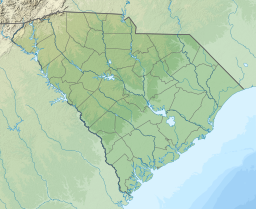| Lake Keowee | |
|---|---|
 | |
| Location | Oconee / Pickens counties, South Carolina, United States |
| Coordinates | 34°48′00″N 82°53′12″W / 34.80000°N 82.88667°W |
| Type | Reservoir |
| Primary inflows | Keowee River[citation needed] Little River Whitewater[1] Thompson[1] Toxaway[1] Lake Jocassee |
| Primary outflows | Keowee River[citation needed] Seneca River Savannah River |
| Basin countries | United States |
| Max. length | 26 miles (42 km)[2] |
| Max. width | 3 miles (4.8 km)[2] |
| Surface area | 18,500 acres (75 km2)[2] |
| Average depth | 53 feet (16 m)[3] |
| Max. depth | 150 ft (46 m)[3] |
| Shore length1 | 387 miles (623 km)[3] |
| Surface elevation | 800 feet (240 m) |
| Settlements | Arial, Clemson, Dacusville, Easley, Liberty, Pickens, Salem, Seneca, Walhalla, and Westminster |
| 1 Shore length is not a well-defined measure. | |
Lake Keowee is a man-made reservoir in the United States in the state of South Carolina. It was developed to serve the needs of power utility Duke Energy and public recreational purposes. It is approximately 26 miles (42 km) long, 3 miles (4.8 km) wide, with an average depth of 54 feet (16 m), and a shoreline measured at 300 miles (480 km) in total,[2] and is approximately 800 feet (240 m) above sea level.
The massive demolition and building project began in 1971 with the construction of two large dams––Keowee Dam and Little River Dam, built on the rivers of the same names. The project covered 18,372 acres (74.35 km2).[4][5] The lake collects or impounds waters from the Keowee River and the Little River and others. The outflows below the respective dams join to form the Seneca River, which flows into the larger Savannah River.
Lake water is used to cool Duke Energy's three nuclear reactors located at the Oconee Nuclear Generating Station. In addition, the dams help generate hydroelectric power. The Keowee Hydro Station generates 158 megawatts from the lake's outflows. Lake Keowee has provided a recreational destination for fishing, boating, swimming, sailing, kayaking and other watersports. The lake has been described as having pure and clean water.
The name Keowee (ᎨᎣᏫ) is a Cherokee word: it is roughly translated as "place of the mullberries." The historic Keowee Town had been located on the bank of the Keowee River and was the largest of the seven Cherokee Lower Towns in the colonial period, in what became the state of South Carolina. Both the town and the former Keowee River were inundated by the formation of Lake Keowee. Archeological excavations conducted in advance of the project by the University of South Carolina recovered thousands of artifacts, as well as evidence of human and animal remains. There was a traditional burial ground at the town.
- ^ a b c Cite error: The named reference
twsG33was invoked but never defined (see the help page). - ^ a b c d "Lake Keowee, South Carolina". SCIWAY. 2011-11-10. Retrieved 2011-11-10.
Today, 18,500 acres of water and a 300-mile shoreline make Lake Keowee a popular place for boating, fishing, water-skiing, swimming, camping, and picnicking....
- ^ a b c "Lakes and Waterways".
- ^ "South Carolina State Parks - Lakes". Archived from the original on 2007-11-24. Retrieved 2007-12-02.
- ^ Cite error: The named reference
twsG44ccwas invoked but never defined (see the help page).
